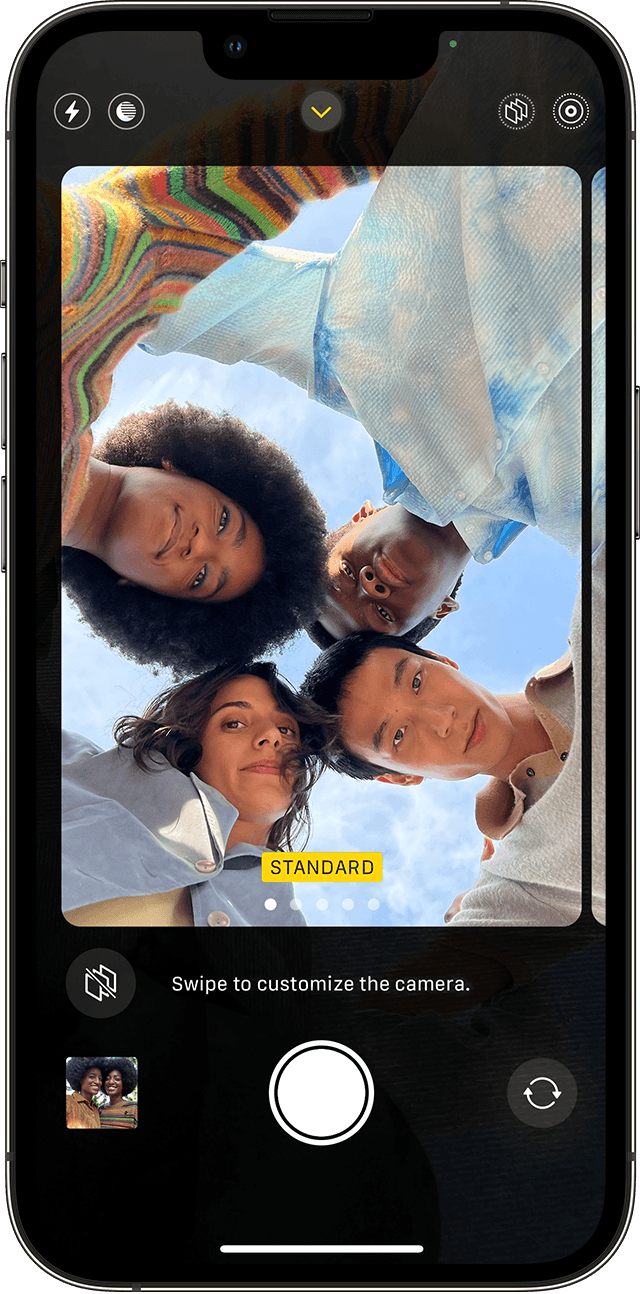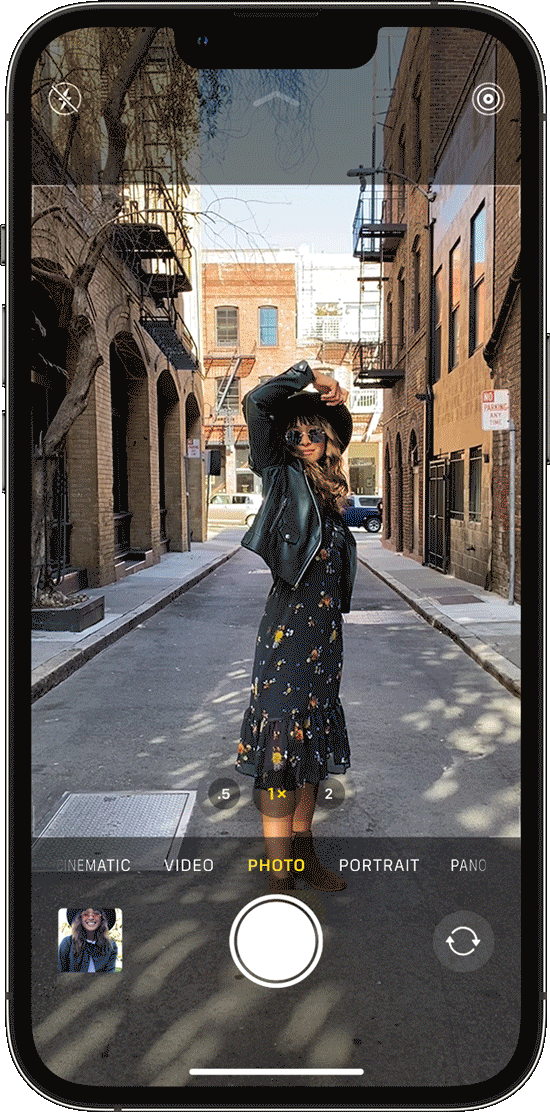What Does A Camera Do
Most the Photographic camera features on your iPhone
Acquire about Photographic Styles, QuickTake, the Ultra Wide camera, and other camera features on your iPhone.
Lock in your wait with Photographic Styles
With Photographic Styles on iPhone thirteen models, you can personalize the expect of your images in the Camera app. Choose a preset — Rich Contrast, Vibrant, Warm, or Cool — and if you want, fine-tune it even further past adjusting the Tone and Warmth settings. Gear up your way in one case to apply your preferred style setting every time you take a photograph in Photo mode.

Ready a Photographic Style
When yous open the Photographic camera app for the first time, tap Set to choose your Photographic Style. Swipe through the different styles and tap Use [Style Proper name] on the preset that you like.
Make sure to set your fashion earlier you start taking photos — you tin can't add your Photographic Mode to a photo after you've already taken it.

Capture close-ups with macro photos and video
iPhone xiii Pro and iPhone 13 Pro Max introduce macro photography, using the new Ultra Broad camera with advanced lens and motorcar-focus organisation for stunning close-ups with precipitous focus as close every bit 2 centimeters. iPhone 13 Pro and iPhone 13 Pro Max can too shoot macro videos, including irksome-motion and fourth dimension-lapse.
Shooting macro in Photo and Video modes is automatic — merely motility your iPhone shut to the subject and the camera will automatically switch to the Ultra Wide camera if it'due south non selected, while maintaining your framing. To shoot macro slow-move or time-lapse videos, select the Ultra Wide camera (.5x) and move close to the field of study.
You might see the Camera app transition to the Ultra Broad camera as y'all motility your iPhone close to or away from a subject. You tin control automated macro switching by going to Settings > Photographic camera, and so turning on Macro Control. With Macro Control on, your Camera app displays a macro button ![]() when your iPhone is within macro distance of a subject. Tap the macro button to plow off automatic macro switching, and tap information technology again to turn automatic macro switching back on.
when your iPhone is within macro distance of a subject. Tap the macro button to plow off automatic macro switching, and tap information technology again to turn automatic macro switching back on.
If yous turn on Macro Command, automatic macro switching is enabled the next time y'all use the photographic camera within macro altitude. If you want to maintain your Macro Control setting between camera sessions, become to Settings > Camera > Preserve Settings and turn on Macro Control.

Grab a video with QuickTake
You can use QuickTake to record videos without switching out of photograph mode. QuickTake is bachelor on iPhone XS, iPhone XR, and afterwards.

Hold the shutter to take a video
When you lot open the Camera app, you meet the default photograph mode. Tap the Shutter push button![]() to have a photo. So tap the arrow
to have a photo. So tap the arrow![]() to adjust options, like wink, Live Photos, timer, and more.
to adjust options, like wink, Live Photos, timer, and more.
If y'all want to capture a QuickTake video, just press and agree the Shutter button ![]() .* Release the button to stop recording.
.* Release the button to stop recording.
With iOS 14 and later, you lot tin hold one of the Volume buttons to capture a QuickTake video. If you have Use Volume Up for Outburst enabled, you tin can employ the Volume down button to capture a QuickTake video.
Slide to the correct to lock recording
To keep recording video without having to concur the button, slide the Shutter button ![]() to the right, and so release it. When video recording is locked, a Shutter push button appears to the right. Tap the Shutter push button
to the right, and so release it. When video recording is locked, a Shutter push button appears to the right. Tap the Shutter push button ![]() to take a however photo during video recording. When you're ready to terminate recording, tap the record push button.
to take a however photo during video recording. When you're ready to terminate recording, tap the record push button.
Slide to the left for burst mode
Slide the Shutter button ![]() to the left and hold it to take a burst of photos, and so release it to cease.
to the left and hold it to take a burst of photos, and so release it to cease.
With iOS fourteen and later, you can capture photos in burst mode by pressing the Volume upward push. Simply get to Settings > Camera and turn on Use Book Up for Flare-up.
* To take videos with customizable resolution, stereo audio, and audio zoom, switch to Video manner.

Arrange your focus and exposure
Before y'all take a photo, the camera automatically sets the focus and exposure, and face detection balances the exposure beyond many faces. You can use Exposure Bounty Control to precisely ready and lock the exposure for upcoming shots.
Just tap the pointer![]() , then tap
, then tap![]() and adjust your exposure level. The exposure locks until the adjacent time you open the Camera app.
and adjust your exposure level. The exposure locks until the adjacent time you open the Camera app.
Exposure Bounty Command is available on iPhone xi, iPhone xi Pro, and after with iOS fourteen or later.

Take a mirrored selfie
With iOS 14 and later on, y'all tin take a mirrored selfie that captures the shot as you lot see information technology in the photographic camera frame. To turn Mirror Front Camera on, go to Settings > Camera, and so turn on the setting.
The Mirror Front end Camera for photo and video is available on iPhone XS, iPhone XR, and later. If you have an iPhone 6s to iPhone 10, the setting is called Mirror Front Photos and captures photos only.

Capture photos even faster
You tin use Prioritize Faster Shooting to modify how images are processed, allowing you to capture more photos when you lot chop-chop tap the Shutter button ![]() . To turn this off, go to Settings > Camera, and turn off Prioritize Faster Shooting.
. To turn this off, go to Settings > Camera, and turn off Prioritize Faster Shooting.
Prioritize Faster Shooting is available on iPhone XS, iPhone XR, and later with iOS 14 or later on.

Enhance your selfies and Ultra Wide photos
With Lens Correction, when yous take a selfie with the front-facing camera or a photograph with the Ultra Wide (0.5x) lens, information technology automatically enhances the photos to make them appear more than natural. To turn this off, become to Settings > Camera, and plow off Lens Correction.
Lens Correction is bachelor on iPhone 12 models and afterward.

Do more with the camera on your iPhone
- Need to capture photos in low-lighting conditions? Larn how to use Night Mode on supported iPhone models.
- Apply Live Photos to capture moments with movement and sound.
Published Date:
Source: https://support.apple.com/en-us/HT210571
Posted by: lambrightposix1941.blogspot.com

0 Response to "What Does A Camera Do"
Post a Comment